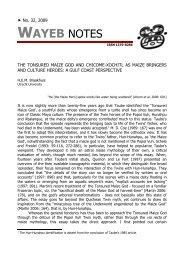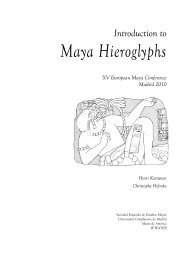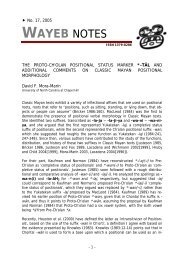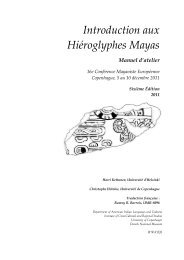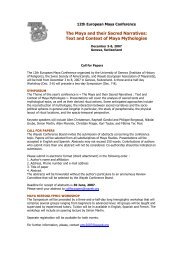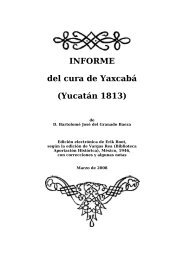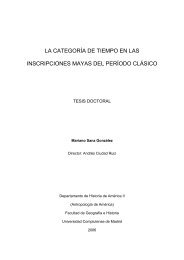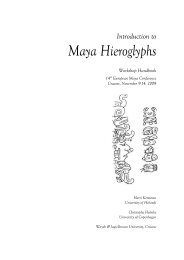Introduction to Maya Hieroglyphs - Wayeb
Introduction to Maya Hieroglyphs - Wayeb
Introduction to Maya Hieroglyphs - Wayeb
Create successful ePaper yourself
Turn your PDF publications into a flip-book with our unique Google optimized e-Paper software.
Kettunen & Helmke 2011<br />
Glossary of Linguistic Terminology<br />
GLOSSARY OF LINGUISTIC TERMINOLOGY 84<br />
absolutive<br />
Absolutive is a grammatical category of NOUNS in ergative-absolutive languages that typically marks the PATIENT<br />
in a transitive sentence and the only ARGUMENT in an intransitive sentence. Furthermore, absolutive is less likely<br />
<strong>to</strong> be formally indicated on the noun than ERGATIVE case is.<br />
accent<br />
A term principally used <strong>to</strong> designate a change of pitch indicating that a particular element (e.g a SYLLABLE) in an<br />
utterance is more prominent than others. The word is also used for accent marks in writing, and (in everyday<br />
language) for diverse accents of different speakers of the same language. See also STRESS.<br />
active voice<br />
Normal form of TRANSITIVE verbs declaring that the person or any other entity represented by the grammatical<br />
SUBJECT performs the action represented by the VERB.<br />
adjective<br />
A word that modifies a NOUN <strong>to</strong> indicate e.g. its quality (examples: green, large, ripe, sacred, celestial, new, etc.).<br />
adverb<br />
A word which modifies a VERB, an ADJECTIVE, another adverb, a phrase, a clause, or a sentence expressing a<br />
relation in reference <strong>to</strong> e.g. time, place, number, direction, affirmation, or denial (examples: then, not, here, far,<br />
after, already, etc.). A useful hint is that basically any word with lexical content that does not clearly fall in<strong>to</strong> the<br />
categories NOUN, VERB, or ADJECTIVE is more often than not considered an adverb.<br />
affix<br />
Generally a dependent (bound) MORPHEME which can be added <strong>to</strong> a STEM or ROOT (as PREFIXES, SUFFIXES, or INFIXES)<br />
in the process of forming a complex word (e.g. in the word disappointment the prefix is dis-, and the suffix is -<br />
ment). In <strong>Maya</strong> hieroglyphs affixes can also work as phonetic complements or in the case of infixes also as<br />
complete words. Contrary <strong>to</strong> standard practice in linguistics, affixes are subdivided <strong>to</strong> prefixes (before),<br />
superfixes (above), subfixes (below), postfixes (after), and infixes (within) in <strong>Maya</strong> epigraphy due <strong>to</strong> the nature of<br />
the script.<br />
affricate<br />
A complex CONSONANT which is composed of a STOP followed instantaneously by a FRICATIVE. Both the s<strong>to</strong>p and<br />
the fricative have generally the same place of articulation. For example the affricate [č] (or [t š ]) as the grapheme<br />
(DIGRAPH) in the word “child” consists of an alveolar s<strong>to</strong>p [t] followed by a pala<strong>to</strong>-alveolar fricative [š]. In<br />
<strong>Maya</strong> languages the affricates behave phonologically as units, and thus cannot be divided in<strong>to</strong> two distinct<br />
PHONEMES, i.e. the phonemes in the TRANSITIVE VERB tzutz (<strong>to</strong> end, <strong>to</strong> complete) are /t s /, /u/, and /t s /, respectively,<br />
whereas in English the sequence of a STOP and a FRICATIVE (i.e. a sound phonetically comparable <strong>to</strong> affricates) can<br />
form two phonemes, as in the word “cats”: /k/, /æ/, /t/, and /s/. In the Classic <strong>Maya</strong> there are four affricates, the<br />
voiceless and (or [t s ] and [č], respectively), and the glottalized and (or [t s ’] and [č’],<br />
respectively).<br />
84<br />
Based partly on Anttila 1972, Bickford and Tuggy (eds.) 2001, Bricker 1986, 1992, 2000b, Carr 1993, Don, Kerstens, and Ruys 1999, Iivonen,<br />
Horppila, Heikkonen, and Rissanen 2000, Kettunen 2002, Kosunen and Väisänen 2001, Lacadena and Zender 2000, Loos, Anderson, Day, Jordan,<br />
and Wingate (eds.) 1999, and Nodine 1996. The entries are cross-referenced in the text in SMALL CAPITAL LETTERS. The graphemes are indicated by<br />
, phonemes by /slashes/, and phonetic sounds by [brackets], i.e., for example, the letter“c” in the English word “can” is<br />
graphemically written as , phonemically as /k/, and phonetically as [k h ].<br />
130/154



